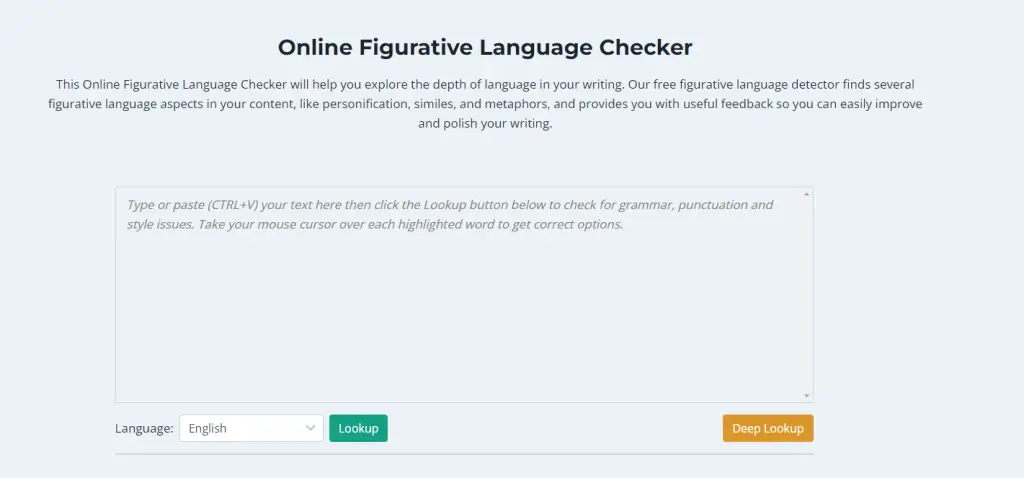Figurative language is a literary device that enhances writing by adding layers of meaning and depth through imaginative expressions. It deviates from the literal meaning of words to create vivid imagery, evoke emotions, and captivate readers.
Discover how Online Figurative Language Checker can elevate your writing by uncovering layers of meaning and enhancing your use of imaginative expressions, captivating readers with vivid imagery and evoked emotions.
Authors employ figurative language to enrich their storytelling and convey complex ideas in a compelling manner.
Table of Contents

What is Figurative language?
Figurative language is when words and expressions are used to convey a deeper or more vivid grasp of a concept or idea, going beyond their literal meaning. It frequently makes use of personification, metaphors, similes, hyperbole, and other literary elements to arouse the reader’s emotions, produce imagery, or deepen their comprehension.
Figurative language gives writing more depth and complexity and makes it easier for authors to convey difficult concepts in a way that readers will find memorable.
“To exist, or not to exist: that is the query:
Whether it is more honorable to endure
The hardships and misfortunes of fate,
Or to take action against a multitude of troubles,
And by opposing, bring them to an end?”
Metaphor: A direct comparison between two unrelated things, suggesting that one thing is another.
Example: “Her smile was a ray of sunshine.”
Simile: A comparison between two unlike things using “like” or “as.”
Example: “He fought like a lion on the battlefield.”
Personification: Giving human characteristics to non-human objects or animals.
Example: “The wind whispered through the trees.”
Hyperbole: Exaggeration for emphasis or effect.
Example: “I’ve told you a million times to clean your room!”
How does identifying run-on sentences affect the effectiveness of using figurative language in writing?
The detection of run-on sentences can significantly impact the effectiveness of figurative language usage in writing by ensuring clarity and coherence in the expression of literary devices. Run-on sentences, characterized by the absence of proper punctuation or conjunctions to separate independent clauses, often disrupt the flow of a sentence and can obscure the intended meaning.
When run-on sentences are present, readers may struggle to interpret the figurative language employed within the text, diminishing its impact and effectiveness. With the help of a powerful run on sentence checker, authors may find and fix these mistakes, maintaining the coherence and impact of their figurative language.
By identifying and correcting run-on sentences, writers can enhance the readability of their work, allowing figurative language to shine through more clearly and powerfully.
This clarity enables readers to fully appreciate the depth and nuances of the figurative language, thus enriching their overall understanding and engagement with the text. Therefore, the detection and correction of run-on sentences play a crucial role in optimizing the impact and effectiveness of figurative language in writing.
The Role of Figurative Language in Writing:
Figurative language plays a crucial role in writing by adding depth, vividness, and emotion to the text. It allows writers to convey abstract ideas, emotions, and concepts in a more engaging and memorable manner. By using metaphors, similes, personification, and other literary devices, writers can evoke imagery, create mood, and enhance the reader’s understanding and emotional connection to the text. Figurative language helps writers to paint a richer and more nuanced picture of their ideas, making their writing more powerful and effective.

How Figurative Language Is Used in Storytelling:
In storytelling, figurative language serves to transport readers into the world of the narrative by engaging their senses and emotions. Writers use metaphors, similes, and other devices to create vivid imagery that helps readers visualize scenes, empathize with characters, and immerse themselves in the story. Figurative language also allows writers to convey complex emotions, themes, and character development more effectively, adding depth and nuance to the storytelling experience. By using figurative language strategically, storytellers can captivate their audience and leave a lasting impression.
The Connection Between Figurative Writing and Imagery:
Figurative writing and imagery are closely interconnected, as figurative language is often used to create vivid mental images in the reader’s mind. Through metaphors, similes, and other devices, writers evoke sensory details and paint scenes that appeal to the reader’s imagination. By engaging the reader’s senses, figurative language helps to bring the narrative to life, making it more immersive and compelling. Imagery, fueled by figurative language, allows readers to see, hear, feel, and experience the story as if they were part of it, enhancing their enjoyment and understanding of the text.
How Figurative Language Works in Poetry
Figurative language plays a fundamental role in poetry, enriching it with depth, emotion, and imagery. Here’s how figurative language works in poetry:
Creating Vivid Imagery: Poets often use metaphors, similes, and other figurative devices to paint vivid pictures in the reader’s mind. By comparing one thing to another, poets evoke sensory details and appeal to the reader’s imagination, making their poems more visually stimulating.
Expressing Emotions: Figurative language allows poets to convey complex emotions and experiences in a condensed and evocative manner. By employing metaphors, symbolism, and personification, poets can express feelings that might be difficult to articulate directly, adding layers of depth and resonance to their work.
Enhancing Sound and Rhythm: Figurative language can also contribute to the musicality and rhythm of poetry. Alliteration, assonance, and other sound devices are often used to create pleasing patterns of repetition and rhythm, enhancing the auditory experience of the poem and drawing the reader’s attention to key themes and images.
Adding Layers of Meaning: Through the use of figurative language, poets can imbue their work with multiple layers of meaning. Metaphors and symbols can carry both literal and symbolic significance, inviting readers to interpret the poem on deeper levels and encouraging personal reflection and engagement.
Inviting Interpretation: Figurative language encourages readers to engage actively with the poem, as they explore the various meanings and associations conveyed through metaphor, imagery, and symbolism. This openness to interpretation allows for a rich and multifaceted reading experience, making poetry a dynamic and rewarding form of expression.
Final Thoughts:
Figurative language in poetry serves as a powerful tool for poets to convey their thoughts, emotions, and experiences in a way that resonates with readers on intellectual, emotional, and aesthetic levels. Through the skillful use of metaphor, simile, symbolism, and other devices, poets craft language into works of art that captivate the imagination and inspire contemplation.






